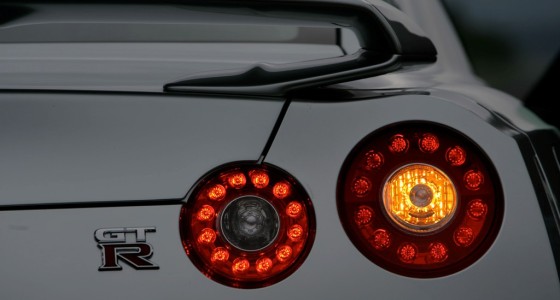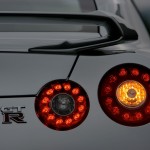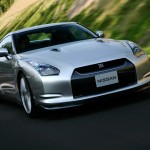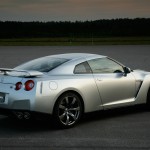
Godzilla’s Kin
Posted In Cars
If you’re anything like me, you’ve fantasized about Godzilla quite often. Not the kaiju (Japanese monster) that graced  the screens, video games, and comic books worshipped by so many sci-fi aficionados, but the Nissan Skyline (R32) coined Godzilla by the Australian motoring press after dominating the Bathurst 1000 Classic in 1991 and 1992. I fell in love with the Skyline GTR before it was nearly unobtainable in the United States. I can remember the first one I sat in- a gunmetal R32 imported by a friend through Motorex. I loved the aggressive body lines with widebody fenders and large intercooler peering through the open-mouthed front bumper. The seats were designed to hold the front passengers in like a straightjacket and I giggled at the disturbed reactions from unsuspecting neighboring drivers as they realized the left side passenger had both arms and legs out the window; the concerned look on their faces as they mouthed, “Who’s driving the car???” Oh yeah, that’d be the right side passenger using his or her “stranger hand.” Motorex helped popularize the Skyline in the US, giving many people the chance to see in person what they dreamed about in magazines, especially on the West Coast.
the screens, video games, and comic books worshipped by so many sci-fi aficionados, but the Nissan Skyline (R32) coined Godzilla by the Australian motoring press after dominating the Bathurst 1000 Classic in 1991 and 1992. I fell in love with the Skyline GTR before it was nearly unobtainable in the United States. I can remember the first one I sat in- a gunmetal R32 imported by a friend through Motorex. I loved the aggressive body lines with widebody fenders and large intercooler peering through the open-mouthed front bumper. The seats were designed to hold the front passengers in like a straightjacket and I giggled at the disturbed reactions from unsuspecting neighboring drivers as they realized the left side passenger had both arms and legs out the window; the concerned look on their faces as they mouthed, “Who’s driving the car???” Oh yeah, that’d be the right side passenger using his or her “stranger hand.” Motorex helped popularize the Skyline in the US, giving many people the chance to see in person what they dreamed about in magazines, especially on the West Coast.
While the earlier Skyline chassis had decently powerful (for the time) 4 cylinder or Inline 6 options, the most well known engine series in the Skyline began with the RB series introduced in the R31 chassis. The RB series used 6 larger intake runners instead of the 12 smaller ones in the L series engines from before. Engine control systems maintained air flow and runner characteristics, and the addition of a larger turbo provided 215 horsepower in the first edition. The R32 was rated at 276 horsepower as part of a gentleman’s agreement among Japanese car makers at that time to limit engine’s horsepower to 276 in a country with a 60mph speed limit. In reality, the R32 produced almost 50 more horsepower than advertised, and with some slight modifications to the stock boost level and a few tuning adjustments, the engine could go from a tame circus monkey to ape-shit in no time- well, at least an under 13 second quarter mile.
The R33 and R34 chassis’ were subsequently introduced, each with more displacement, more boost, and more power. The R33 RB25DET included a variable valve timing control and in 1996 Nissan decided hmmm… with all that power, maybe we should give it a set of brakes in order to stop adequately. From then on, all GTR’s were equipped with Brembo brakes. In 1998, the R34 became the import culture mascot. It was “phatter” and squatter, and just all out bitchin’ leering at the cowering competition from behind a sexy set of headlights. The Skyline was hyped up in Gran Turismo, Fast and the Furious, and covered by every magazine on the shelf, even the Honda ones. Powered by the RB26DETT, it was luxurious enough to take out royalty, but quick enough and powerful enough to reign supreme on the track.
Nissan also decided upgrades in the suspension and active differential were necessary in order to let you to keep all that power from being applied to four spinning tires pointed towards the sky. HICAS was introduced in the R31 chassis as a four wheel steering system that reacts to driving conditions by controlling the wheels direction for optimal cornering, tighter turning radius, and quicker reactions. Super HICAS was introduced in the R33 as Nissan started using electronic actuators instead of hydraulic lines, improving both the reliability and handling that could save you from pulling a shitty into the brush. Nissan replaced the standard viscous differential with an active rear differential that locked in the event of tire slip, and also installed a dummy light if you were stupid enough to not realize you were no longer in control of your car’s direction, now pointed somewhere between a rock and a hard place. ATTESA ETS is an active yaw (lateral movement) that uses 3 Y axis G sensors at a 16 bit processor to monitor your brakes and movements over 100 times per second to direct where to send the power, anywhere from a split 50:50 front/rear ratio at a stop to 2:98 at a hard launch. ATTESA ETS was your lifeline, that thing you called upon when you found yourself nose to nose with a tree or a cliff, and it pulled you back just seconds from mating with the other object.
Alas, Nissan killed the R chassis, replacing it with the V35. Ok, so it’s not the same rebel it once was. Where the R34 may have smacked the competition with whips and chains, the V35 prefers a gentle spanking. The R34 is like a dirty, shaken martini but the V35 is the stirred and clean version. But I can’t complain. The V35 has decent, naturally aspirated power, better aerodynamics, and some additional bracing, and most importantly to me, it was readily available at US dealerships. It has since become one of the most popular sporty cars on American roads today. And with the introduction of the VQ37VHR engine in the G37 and 370z, also one of the most powerful. Visit us at www.370z.com to see what it’s all about!
 Nonetheless, the tuner market mourned for the “real” Skyline. And in October 2007 at Tokyo Motor Sport, Nissan unveiled the GTR. It doesn’t carry the moniker Skyline, but the GTR is a new monster powered by a VR38DETT. Each GTR engine is hand built and while their outputs vary, they are somewhere in the neighborhood of 480 horsepower.
Nonetheless, the tuner market mourned for the “real” Skyline. And in October 2007 at Tokyo Motor Sport, Nissan unveiled the GTR. It doesn’t carry the moniker Skyline, but the GTR is a new monster powered by a VR38DETT. Each GTR engine is hand built and while their outputs vary, they are somewhere in the neighborhood of 480 horsepower.  A newly designed rear wing and an underbody diffuser keep the GTR glued to the ground. Outfitted with bigger rubber and better brakes, this car was sold out at US dealerships before it had even set foot on US soil, even with the $85k price tag. It might not conquer the Empire State Building, but it will tear about a track like nobody’s business.
A newly designed rear wing and an underbody diffuser keep the GTR glued to the ground. Outfitted with bigger rubber and better brakes, this car was sold out at US dealerships before it had even set foot on US soil, even with the $85k price tag. It might not conquer the Empire State Building, but it will tear about a track like nobody’s business.
And if the AWD twin turbo monster isn’t enough for you, the GTR SpecV will go on sale February 2, 2009 at seven select Nissan dealerships in Japan. The interior is draped in carbon fiber trim with custom carbon fiber Recaros replacing the GTR’s rear seats. There are also carbon fiber grille, spoiler, and brake ducts. A new boost controller provides more torque in the mid to high powerband as well as offering better fuel economy, although it’s probably not much of an improvement when the throttle is pegged to the floor. Nismo forged aluminum alloy wheels fit nicely over the carbon ceramic brakes. And gold? No. Platinum? Nuh-uh. “Bling, Bling, who’s calling?”Oh, just a titanium coated exhaust system, that’s all. The GTR SpecV comes in four mainstream colors, Super Black, Vibrant Red, Brilliant White Pearl, and Dark Metal Gray, as well as one exclusive color, Ultimate Black Opal.At just under $170,000, I’ll need a little help to get behind the steering wheel of one. Donations may be made to the SWAG (Sarah Wants a Gtr) fund.

What kind of car do you have again?
All Nissan/Infiniti’s. You can read more about a few of them in the “Here a car…” blog.
Wow, your place must be like my Gradfather’s used car lot 🙂
Wow nice car, I love it.
[…] “GT-R Dun”- This Godzilla can capture me any […]